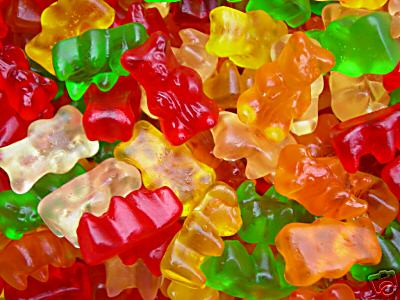A co-worker and I were chatting over lunch the other day. We both try to eat healthy but admittedly, we all have weaknesses. We started talking about our favorite junk food items and I shared that I used to love gummy bears and marshmallow peeps, but I had to give them up because of the gelatin used to make them.
If you’re not as crazy as I am, you may wonder what’s wrong with gelatin. Many of us were raised on the jiggly, fruity stuff. Jell-O uses gelatin as its main ingredient and what could be more all-American then Jell-O? Unfortunately, not much.
According to People for the Ethical Treatment of Animals, “Gelatin is protein obtained by boiling skin, tendons, ligaments, and/or bones with water. It is usually obtained from cows or pigs. Gelatin is used in shampoos, face masks, and other cosmetics; as a thickener for fruit gelatins and puddings (such as Jell-O); in candies, marshmallows, cakes, ice cream, and yogurts; on photographic film; in vitamins as a coating and as capsules; and it is sometimes used to assist in ‘clearing’ wines.”
OK, so it’s pretty gross to have this information. It may even make you feel a bit sick. It definitely put a damper on lunch. But that’s not why I avoid gelatin. In theory, I’m actually for the practice of using all of the animal.
I am not a vegetarian. I believe that if we are going to be meat eaters, we should show respect to the animal that gave its life for us by not throwing nearly half of it on a trash heap. And in reality, if we are meat eaters, meat in our non-meat products, though surprising, should not be disturbing. We were going to eat the meat anyway.
As a matter of fact, I think the rendering process is admirable, in theory, and on a small scale. Gelatin, tallow and other animal products have been used for generations, in cooking and to make soaps and other products.
Wisegeek.com spells out why I am against using these products from today’s rendering industry:
“A rendering plant is a processing operation where dead animals are recycled into products from human food to biodiesel. The remains and waste from slaughterhouses are the primary contributors to these facilities. Heads, hooves, bones, blood, offal (internal organs) and anything else that cannot be used ends up at a rendering plant.
 “Carcasses of dead animals from livestock and confinement operations are the secondary contributors. A rendering plant will also take dead horses, llamas and other farm and zoo animals. Remains of dogs and cats, roadkill (deer, skunks, rats and raccoons) end up there as well. Veterinary clinics and animal shelters also rely on rendering plants for their euthanized animals. They also accept throwback or rejected meat from supermarkets.”
“Carcasses of dead animals from livestock and confinement operations are the secondary contributors. A rendering plant will also take dead horses, llamas and other farm and zoo animals. Remains of dogs and cats, roadkill (deer, skunks, rats and raccoons) end up there as well. Veterinary clinics and animal shelters also rely on rendering plants for their euthanized animals. They also accept throwback or rejected meat from supermarkets.”
The cast-off parts used to make gelatin and tallow come from confined animal feeding operations, or, factory farms. I strongly oppose factory farming and will not support the industry. And I have some personal issues with wondering if the lipstick I’m using was derived from a formerly zoo-bound giraffe or some poor, lonely dog that never got rescued from the shelter.
But have no fear, if you simply can’t live without them, you don’t have to say good-bye to jellied candies or that jiggly, fruity dessert forever. Agar agar is another item used to help make foods gel and it’s derived from seaweed (phew).
From www.food.com, a vegan “jello” gelatin:
Ingredients:
1 quart fruit juice
4 -5 tablespoons agar-agar flakes or 4 -5 teaspoons agar-agar powder
1 pinch sea salt
chopped fruit
Directions:
Place liquid, salt and agar-agar into saucepan, stir to dissolve the flakes. Bring to a boil, reduce flame and simmer for 2 – 3 minutes. Place any additional ingredients (fruits, etc) into a shallow bowl and pour hot liquid overall. Chill until jelled.
Are you planning on giving up your Swedish fish? Have I made you run to your mascara to read the label? You can tell me how annoyed you are that I’ve ruined Easter (and every other candy-laden holiday) for you at laurie@riverheadlocal.com.
![]()

Laurie Nigro, a mother of two, is passionate about natural living. Laurie resides in downtown Riverhead and is co-founder of the River and Roots Community Garden on West Main Street. Contact her by email to laurie@riverheadlocal.com.
The survival of local journalism depends on your support.
We are a small family-owned operation. You rely on us to stay informed, and we depend on you to make our work possible. Just a few dollars can help us continue to bring this important service to our community.
Support RiverheadLOCAL today.






























